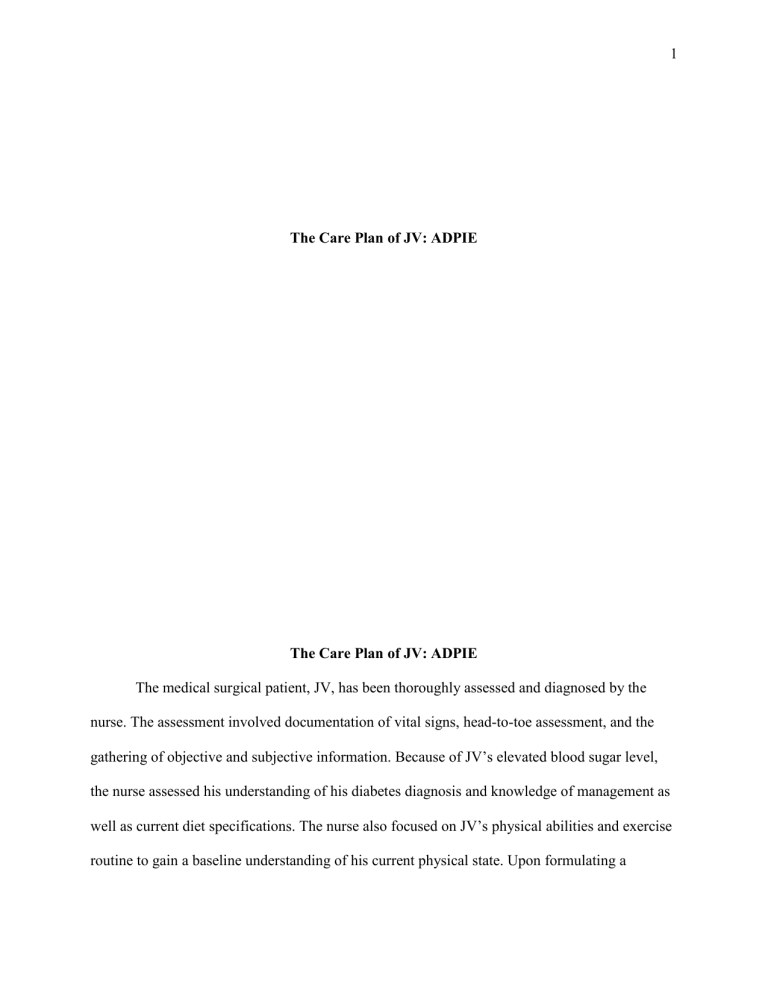
1 The Care Plan of JV: ADPIE The Care Plan of JV: ADPIE The medical surgical patient, JV, has been thoroughly assessed and diagnosed by the nurse. The assessment involved documentation of vital signs, head-to-toe assessment, and the gathering of objective and subjective information. Because of JV’s elevated blood sugar level, the nurse assessed his understanding of his diabetes diagnosis and knowledge of management as well as current diet specifications. The nurse also focused on JV’s physical abilities and exercise routine to gain a baseline understanding of his current physical state. Upon formulating a 2 diagnosis, the nurse acknowledged JV’s current health state which included an oxygen saturation of 88%, a productive cough, and a blood sugar level of 312. The working nursing diagnosis resulted in impaired gas exchange and poor glucose management. Planning and Implementation Phases Moving through the planning and implementation processes, the nurse must establish their priorities by organizing the number of nursing diagnoses or patient problems to establish a preferential order for nursing interventions (Potter et al., 2021). In general, problem-oriented diagnoses and issues take precedence over wellness, potential risk, and health-promotion issues. In most cases, short-term acute patient care demands and problems take precedence over longterm chronic needs. Priority setting is the arrangement of a patient's intended outcomes, not the ordering of a list of care chores. Interprofessional collaboration is a complicated process in which two or more people from different areas work together to achieve common goals for a patient (Potter et al., 2021). Interprofessional education, role awareness, interpersonal connection skills, purposeful intervention, and interprofessional team support are the aspects that must be in place before interprofessional collaboration may be successful. Positive leadership and management characteristics, communication structures, personal rewards, suitable resources and processes, an appropriate skill mix, and clarity of vision, according to Nancarrow and colleagues (2013), are also required. Nurses play a critical role in interprofessional collaboration, especially when it comes to communicating patient needs to all members of the health care team, defining priorities, and ensuring treatment continuity. Patient care is improved, health care practitioners and nurses are happier, costs are controlled, clinical errors are reduced, and patient safety is improved when interprofessional collaboration is well-functioning. In the case of JV, the nurse 3 needs to collaborate with other health care personnel including his primary physician, respiratory therapy, a diabetes specialist, and a dietitian. Nursing Interventions Following the development of a patient's plan of care, the fourth step of the nursing process is implementation. It entails delivering nursing and collaborative treatments in order to meet the goals and expected outcomes necessary to support or improve a patient's health. Any treatment that a nurse conducts to improve patient outcomes based on clinical judgment and knowledge is referred to as a nursing intervention. Nursing interventions are defined as direct and indirect care measures initiated by a nurse, a physician, or another practitioner (Bulechek & McCloskey, 2018). In an ideal world, a nurse would choose evidence-based nursing treatments that provide the most recent, scientifically validated, and up-to-date approaches to providing patient-centered care. To enhance the outcome of JV, the nurse should prioritize the following interventions: medication administration, diabetic diet, vital sign monitoring, respiratory support, glucose monitoring, physician’s orders, promote water intake, oxygenation, oxygenation while sleeping, pain treatment, infection control, reduce fever, and education. Priority Interventions Clinical decision-making includes selecting nursing interventions for a patient. Clinical reasoning and decision-making skills enable the nurse to correctly identify relevant nursing interventions for a patient's specific nursing diagnoses. Nursing interventions are based on the nurses understanding of their patient and the social environment of the health-care setting in which they work. Nursing judgements for recognizing a patient's concerns and intervening successfully are aided by interprofessional partnerships between nurses and health care providers. Decision-making approaches for each clinical setting are based on the context in 4 which the nurse offers care to each patient and the numerous interventions required. One can use critical thinking to assess the complexity of treatments, shifting priorities, alternative approaches, and the amount of time they have to act. Oxygenation would be top priority when organizing the nursing interventions for JV’s plan of care. Following would include pain management, fever reduction, glucose monitoring, insulin administration, and diabetes/medication education. 5 Resources Bulechek, G., McCloskey, J. (2018). Nursing interventions classification (NIC). Medinfo. Nancarrow, S.A., Booth, A., Ariss, S. (2013). Ten principles of good interdisciplinary team work. Human Resources for Health. https://doi.org/10.1186/1478-4491-11-19 Potter, P. A., Perry, A. G., & Stockert, P. (2021). Fundamentals of nursing (10th ed.). Elsevier.




